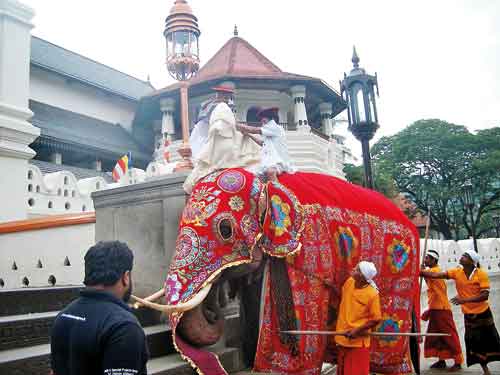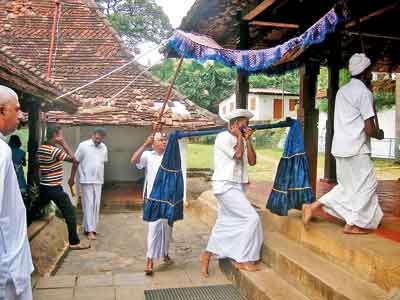As the New Year dawned Sri Dalada Maligawa came alive with annual rice ritual

For the January 1 dane: Entering the Sri Dalada Maligawa with the rice
Every year, the Sri Dalada Maligawa performs four main cultural events: the Aluth Sahal Mangalya on Duruthu Poya in January, Aluth Avurudu Mangalya (Sinhala New Year) in April, Esala Perahera (July/August) and the Kartika Mangalya in November. This year as Duruthu Full Moon Poya fell on January 1, the Alut Sahal Mangalya rituals were conducted from December 28 onwards, by the Sri Dalada Maligawa.
The Kariya Karawana Korala of the Sri Dalada Maligawa explained that there are many rituals leading to this first cultural event of the year which have been followed from the time of the Sinhala kings.
At the auspicious time of 1. 23 in the afternoon on December 28, the Kariya Karavana Korala together with officials from the Udarata (upcountry) vihara and devala, walked in a perahera (procession) to Pallakelle.The Diyawadana Nilame, Basnayake Nilames (Chieftains of the Devalas) and other officials joined the perahera and continued upto the Atuva (barn) where paddy and rice brought in by the people as the rajakariya portion which they have to offer to the Dalada Maligawa, were stored.This is an obligation on those living on land belonging to the Maligawa and cultivating the paddy fields.
After the conclusion of the perahera, drummers, Ves dancers and Pantheru dancers performed in the premises of the barn, in the presence of the Diyawadana Nilame and Basnayake Nilames.Once this ritual was over, everybody was treated to kevum (oil cakes), kiribath (milk rice), bananas and tea. The Secretary to the Maligawa read out the names of the recipients of the Aluth Sahal (new rice) and handed over the portions of rice to them. Thereafter, they returned to Lewella via Kandy and placed the rice in the Gangarama Viharaya in Lewella until the following day.

Rice being taken to the Vishnu Devalaya
Early on the 29th morning from the Gangarama Viharaya, the Maligawa and the four Devalas again with their portions of rice in kada (pingo) went in a grand procession to Kandy. At the auspicious time of 8.45 a.m. the Sri Dalada Maligawa and the four devalas placed the rice in their respective atuwas (barns) to prepare the dana and the pooja on January 1.
Speaking to the Sunday Times H.P.M. Piyasekera said he was the PiligalleVidana and that he was exactly 90 years and 6 months old. He has served the Sri Dalada Maligawa for 60 years, arriving there daily. His Rajakariya, is to provide 16 seru (a kind of measure) of rice every month to the Sri Dalada Maligawa, as he lives on a land belonging to the Maligawa and cultivates the paddy fields. This, he said has been done for many generations of his family. As he is advanced in years, he said, “than mama hamadama maligawata enne nae, badada enawa Nana mura Mangalyata, (Now I do not come everyday to the Malagawa, but only on Wednesday for the Nanamura”(performance of a special ritual for the Sri Dalada).
On January 1, the Muluthan Buddha pooja with the aluth sahal (new rice) prepared with about 80 seru was offered at 9.55 a.m. facing south. Thousands of devotees had come to pay their homage to the Sri DaladaVahanse as it was a very significant day for them. The four Devalas too followed their own rituals and at the same auspicious time offered the pooja to the deities.


